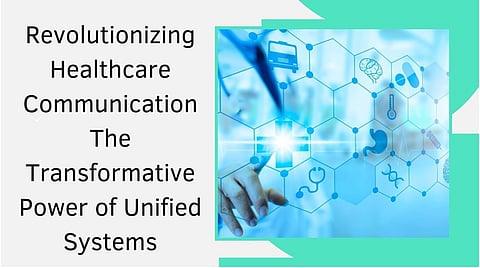

In this era of rapidly evolving healthcare demands, communication systems have become vital for delivering efficient and patient-centered care. Naga Praneeth Yerram highlights how Unified Communications (UC) integration is transforming the industry by unifying voice, video, and secure messaging to enhance collaboration, ensure compliance, and improve care delivery. By addressing critical challenges like fragmented systems and delays, UC systems enable seamless communication, faster decision-making, and superior patient outcomes, revolutionizing operational efficiency and shaping the future of healthcare.
For years, disjointed communication between different units within traditional healthcare settings has led to delay, inefficiency, and sometimes medical error. Unified Communication combines voice, video, and secure messaging into one ecosystem. Thus, information from all parties flows more freely and smoothly for healthcare providers to make faster decisions and to care better.
UC system deployments have proven transformative, especially with voice-over-IP technologies that provide 99.999% uptime reliability-an absolute necessity for critical care scenarios. Real-time video conferencing has also transformed remote consultations, enabling high-definition interactions with minimal latency. Healthcare facilities report a 55% improvement in team collaboration efficiency when integrating such solutions.
Telehealth has become the new paradigm of patient care with the reach of specialized medical services to underserved and rural areas. Improved patient access is 67%, and travel times are reduced by 42% with high-definition video capabilities of telehealth systems. The wait times in virtual waiting rooms have been further reduced by 55% through intelligent queuing systems, improving patient satisfaction.
Further, the accessibility aspects of multilingual support and an application for the mobile have worked very well toward building inclusive health systems. Other benefits include how such advancements create convenience in processes of appointment making and patient participation; this improved a satisfaction rating by 72%.
Modern healthcare has made confidentiality and security of patient information its number one priority. UC systems, with advanced encryption protocols, automated key rotations, and detailed access controls, have improved data protection significantly to assure HIPAA compliance. Its success rates are more than 99.9%.
Also, the existence of continuous monitoring systems combined with highly sophisticated audit trails adds strength to compliance by being in a better position to identify and prevent security breaches before they actually happen. Healthcare institutions using these technologies report significant reductions in attempts at unauthorized access and more efficient reporting of compliance, reflecting how UC systems provide a secure foundation for reliable and regulated healthcare communication.
The Unified Communication (UC) systems are fundamentally changing the way operational workflows happen in healthcare by extending far beyond enhancing connectivity. Healthcare facilities reported a 40% reduction in administrative overhead and 35% in resource utilization after streamlining communication and collaboration. Real-time analytics integration allows precise tracking of equipment and personnel, making sure that there is optimal allocation of resources with reduced inefficiency.
The financial savings are equally significant. Healthcare providers have been able to reduce expenses associated with communications by 30% and overtime by 45% by enhancing the coordination of the staff and efficient management of their tasks. All these efficiencies make more time and resources available, which healthcare professionals can use for providing better care to patients. Thus, in modern healthcare, Unified Communication is driving both operational excellence and better patient outcomes.
The next frontier for healthcare communication would be the advent of innovations that are considered on the cutting-edge, such as artificial intelligence (AI), Internet of Things (IoT), and blockchain. AI-driven care systems revolutionize care by advancing predictive diagnostics, improving the clarity of communication, and automating routine tasks with a view toward significantly reducing administrative burdens. IoT devices have helped in the process of continuous monitoring of patients because they provide an opportunity to obtain real-time information and perform continuous analysis. With this technology, emergency response time has decreased by 40%. Blockchain technology gives data unshakeable integrity through secure, easy-to-navigate pathways to transfer medical information among networks. Additionally, the advent of Extended Reality (XR) is revolutionizing telemedicine by virtue of providing immersive diagnosis that enables a 60% higher accuracy of remote consultation, thus paving the way towards a better future for health care communication.
In conclusion, Naga Praneeth Yerram highlights a transformative path for the healthcare industry through Unified Communications. By integrating innovative communication frameworks, healthcare organizations can overcome traditional barriers, enhance patient care, and achieve operational excellence. As emerging technologies continue to redefine the UC landscape, the possibilities for improving healthcare delivery are boundless. Through his work, he underscores the critical importance of these advancements, offering a vision where technology and healthcare converge to create a more connected and efficient world.
